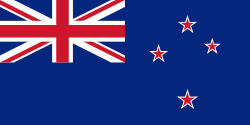Rolleston (Rolleston)
Rolleston (Roretana, Tauwharekākaho) is the seat and largest town in the Selwyn District, in the Canterbury region of New Zealand's South Island. It is located on the Canterbury Plains 22 km south-west of Christchurch, and is part of the wider Christchurch metropolitan area. The town has a population of making it New Zealand's 24th-largest urban area and the third-largest in Canterbury (behind Christchurch and Timaru). It was nicknamed the "Town of the Future" in the 1970s by Prime Minister Norman Kirk. The "Town of the Future" signage has since been removed from the entrances to Rolleston.
Rolleston originated as a railway terminus in 1866, and is named after the Canterbury statesman William Rolleston. Rolleston, who was born in Yorkshire in 1831 and died in 1903, served as Superintendent of the Province of Canterbury from 1868 until 1876 (when central government abolished the New Zealand provinces). He also served as a Member of Parliament, holding various Cabinet portfolios. In the 1970s, Prime Minister Norman Kirk had a dream of turning the town of less than 1,000 people into a city of 80,000. Selwyn District Council proposed an industrial subdivision, Izone, in 2000. The council purchased rural land adjacent to the Main South Line opposite the town the following year. The Warehouse Group developed its South Island distribution centre at the Izone. The Selwyn District Council built the Toka Hāpai Selwyn Health Hub in 2021. The Health Hub was completed in May 2021, and has a Canterbury District Health Board Primary Birthing Unit as well Pacific Radiology, a physiotherapist and may have a general practice service. It was estimated to cost $14.7 million.
In late 2020, the Selwyn District Council were considering applications (private plan changes) to rezone land around Rolleston to accommodate a further 4500 houses. The Christchurch City Council was opposing this until concerns about the “significant adverse effects of downstream traffic within Christchurch” could be addressed.
In 2021, a $85 million shopping centre called Rolleston Fields was planned to be built on the old Rolleston domain on Tennyson Street. It is expected to form part of a new town centre that has been master planned by the Selwyn District Council. It is expected to include cinemas and a covered farmers market. It is planned to be built in four stages. The Selwyn District Council are planning to also build a pedestrian square to provide an "identifiable heart" of the town.
Rolleston originated as a railway terminus in 1866, and is named after the Canterbury statesman William Rolleston. Rolleston, who was born in Yorkshire in 1831 and died in 1903, served as Superintendent of the Province of Canterbury from 1868 until 1876 (when central government abolished the New Zealand provinces). He also served as a Member of Parliament, holding various Cabinet portfolios. In the 1970s, Prime Minister Norman Kirk had a dream of turning the town of less than 1,000 people into a city of 80,000. Selwyn District Council proposed an industrial subdivision, Izone, in 2000. The council purchased rural land adjacent to the Main South Line opposite the town the following year. The Warehouse Group developed its South Island distribution centre at the Izone. The Selwyn District Council built the Toka Hāpai Selwyn Health Hub in 2021. The Health Hub was completed in May 2021, and has a Canterbury District Health Board Primary Birthing Unit as well Pacific Radiology, a physiotherapist and may have a general practice service. It was estimated to cost $14.7 million.
In late 2020, the Selwyn District Council were considering applications (private plan changes) to rezone land around Rolleston to accommodate a further 4500 houses. The Christchurch City Council was opposing this until concerns about the “significant adverse effects of downstream traffic within Christchurch” could be addressed.
In 2021, a $85 million shopping centre called Rolleston Fields was planned to be built on the old Rolleston domain on Tennyson Street. It is expected to form part of a new town centre that has been master planned by the Selwyn District Council. It is expected to include cinemas and a covered farmers market. It is planned to be built in four stages. The Selwyn District Council are planning to also build a pedestrian square to provide an "identifiable heart" of the town.
Map - Rolleston (Rolleston)
Map
Country - New_Zealand
 |
 |
| Flag of New Zealand | |
The islands of New Zealand were the last large habitable land to be settled by humans. Between about 1280 and 1350, Polynesians began to settle in the islands and then developed a distinctive Māori culture. In 1642, the Dutch explorer Abel Tasman became the first European to sight and record New Zealand. In 1840, representatives of the United Kingdom and Māori chiefs signed the Treaty of Waitangi, which in its English version declared British sovereignty over the islands. In 1841, New Zealand became a colony within the British Empire. Subsequently, a series of conflicts between the colonial government and Māori tribes resulted in the alienation and confiscation of large amounts of Māori land. New Zealand became a dominion in 1907; it gained full statutory independence in 1947, retaining the monarch as head of state. Today, the majority of New Zealand's population of 5.1 million is of European descent; the indigenous Māori are the largest minority, followed by Asians and Pacific Islanders. Reflecting this, New Zealand's culture is mainly derived from Māori and early British settlers, with recent broadening of culture arising from increased immigration. The official languages are English, Māori, and New Zealand Sign Language, with the local dialect of English being dominant.
Currency / Language
| ISO | Currency | Symbol | Significant figures |
|---|---|---|---|
| NZD | New Zealand dollar | $ | 2 |
| ISO | Language |
|---|---|
| EN | English language |















